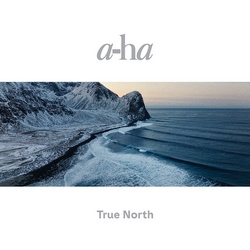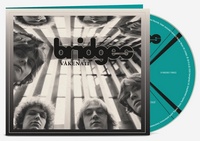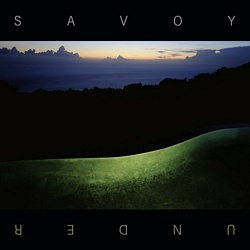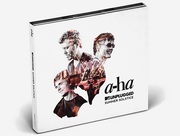Article: The new a-ha is born
– Don’t expect any speech, I said. Everyone who knows me, know that I can’t hold a speech. Then – out of nowhere – “Angel In The Snow” arrived, four days before the wedding. That song became my wedding speech. We recorded it in Magne’s studio the day before the wedding.
From Puls, June 1993
Written by Arild Rønsen. Translation by Jakob
Pål Waaktaar greets us at one of Oslo’s major hotels. Still rather dressed-up after a photo session earlier in the morning, but relaxed and ready to set aside the time needed for an interview. In comparison to his keyboard-bandmate Furuholmen he is not physically marked by the events of yesterday – or rather yesternight. Two-three hundred of us chosen ones had been allowed access to a remarkable event; a-ha live in a club setting. As you’ll see from the review in our live section, it was an unforgettable experience. a-ha aren’t lightweight. They are a pop/rock band that can outperform most acts, including the majority of their originally more hard-rocking colleagues.
The foremost reason for this is named Pål Waaktaar.
He has become an incredibly skilled guitarist. He’s developed an awesome sound, he gives the band a distinct rock expression – and he rips guitar solos on par with Slash. a-ha live at Månefisken was a hundred times more rock and roll than anything Axl and Co. managed when they played at Valle Hovin a few days earlier.
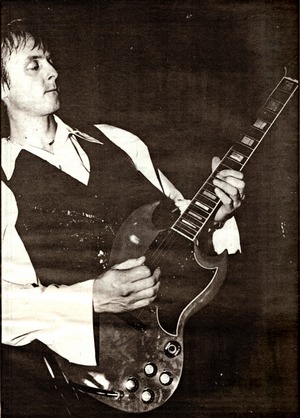
Photo by Bjørn Opsahl
Pål Waaktaar has written the majority of a-ha’s songs. With the release of Memorial Beach, the band’s sixth album, he stands out more than ever as the driving force in the band. Surely, he knows how to fight for his songs within the band, but the reason why he keeps winning is obviously because Magne and Morten have learned to know that Pål writes the best songs. He is a guy who will clearly dismiss any claims that he “owns” the band, so we’ll leave that question out. But we still assume that he’s aware of what everyone else knows: After a-ha, Pål Waaktaar is the only one of the three who has an obvious potential to do a solo career.
Harket may function as a singer in other settings (he was in discussions to join Andrew Lloyd Webber’s musical version of Sunset Boulevard), but his natural stage presence is so limited that he doesn’t really stand a chance – unless he’ll choose to do as we’ve suggested: Make it a point in itself to sit still. Find a stool and stay seated.
Furuholmen? A cool dude, but hardly a songwriter for the twentyfirst century.
– Musical background? Not much, Waaktaar says with a smile. – I met Magne when I was 13. In Bridges we’d rehearse four-five times a week, and right from the start we were writing our own songs.
He applied for music studies in high school, but was never accepted. He couldn’t master the obligatory black and white keys.
– Looking back, I’m glad I wasn’t. Not that I was overly happy in science class, but those three years meant that after my final exams I was really ready for England.
This isn’t the time to recap the story of a-ha, besides remembering how the fantastic three left for England, empty-handed, sometime in the early 80s – and then ended up topping the Billboard chart in September 1985. “Take On Me” is the first and only Norwegian single to have topped the world’s most important music chart. In the following years they would have almost twenty Top 20 singles in the UK.
“Take On Me” was – musically speaking and in a pop-setting – a rather complicated affair. Very catchy, alright – and composed using simple means. But still entirely different from what another chart-topping trio at that time, Stock/Aitken/Waterman, were doing. a-ha wanted to conquer the same fields that Nik Kershaw was operating in. And that’s how it has continued; Pål Waaktaar isn’t a man who churns out traditional three-chord tunes.
– Just listen to the Bridges-album, he says. – The relative keys are lined up.
Relative keys; that’s the kind of expression musicians will use when communicating. It’s about technique and which keys that best “matches” each other. “Take On Me” in a nutshell. And please stay with us for a few more lines of this jargon, as it says a lot about how Waaktaar thinks:
– But “Dark Is The Night” is in F-major, while you’ve added G-minor…? It should have been D-minor, damn it!
– Yeah, but the really weird thing is that the lift-off comes with the C – which actually belongs in a song that goes in F-major! It’s just what happens sometimes, and don’t ask me why. Have you noticed “Move To Memphis”? It’s supposed to be in H-minor, but when the riff appears everything else is in H-major. Magne’s solo switches between E-major and E-minor.
Other musicians would nod approvingly. The rest of us can simply note that some have it and some don’t. Waaktaar is definitely among those who have been equipped with plenty of talent in this department.
– If something other than the melody drives the song forward, it just becomes a mess, he says. – And it has to do with different moods. “Memorial Beach”; a grey day, an abandoned beach – I instantly knew that I had the story for a song. The same thing with “Locust”; it’s like a book that you never want to end. I had the idea lying around for a long time, then I recorded a basic riff, waited an hour, flipped out, and… Yeah, that’s one of the songs that I have a real relation to.
– Traditional three-chord songs? We had a go at it with “I Call Your Name”. But that’s not really our thing. I grew up with The Doors.
No one who hears a-ha live today will fail to notice Pål’s truly magnificent guitar work. When asked if he’s played a lot of guitar lately – simply practiced a lot – he chooses another way of looking at it.
– We found out early on that our songs worked best in a live setting. “We need to translate this to an album”, we thought.
That’s how it is, that a-ha in 1993 sounds more like a “guitar band” than a “keyboard band”.
– With synths you are pre-setting things, programming the sounds you want to use – and then everything is basically ready to go. A guitar doesn’t behave like that. You can’t use presets with guitars. I was very relieved when I found out that David Z was a man who understood that guitars take time.
David Z has produced Memorial Beach. He’s part of Prince’s crew, and many feared that he would make a-ha even more high-tech. Instead, the opposite happened. Memorial Beach is the closest a-ha have ever been to live sound on an album.
– A correct observation. In the past we used to add keyboards, but this time we often added several layers of guitar. Luckily I didn’t have to suggest it myself; David Z wanted to go in the same direction as I did.
But then why have we always thought of Pål Waaktaar as a composer first, an arranger second – and then finally (maybe?) as a solid musician? Even though he now considers this idea to be “nonsense”, he’s probably contributed to this image himself as well.
– You have to remember that we arrived in England without instruments. Therefore we had to use whatever was available in the studio – usually a single synth…
– Memorial Beach is full of high-tech, but the recording itself went by very quickly. Never more than two takes, David Z wouldn’t allow more than that. So we had to rehearse a lot in advance, and I think this had a very positive impact on the final result. “Let’s knock his socks off!”.
– David Z hates unnecessary high-tech. You should have seen the plastic boxes he used in the studio… He impressed me. Notice all the loops in the production; he used them discreetly, so that Per [Hillestad] never disappears.
Per Hillestad (drums) and Jørun Bøgeberg (bass) have finally advanced from associated members to being a-ha’s regular backing band.
– It took us a couple of albums to realize that Norwegian musicians actually are the best you can use. Jørun has a heavy, laidback style, his bass playing is probably very influenced by his background in heavy rock. Per has an easy groove and a playful way of drumming. I really love this backing band. They have identity in their playing, and we have consciously wanted them to sound different in a-ha than when they’re playing with others. The engineers at Paisley Park would often point out how great the backing band sounded.
“Paisley Park”, the rumours would say. “a-ha will be recording in Prince’s studio”. That’s what they did, but only partly. Pål Waaktaar didn’t feel entirely comfortable in the building.
– Paisley Park is OK, but it felt a bit like Norwegian Hydro, if you know what I mean. Not very Prince. Fruit and flowers everywhere… I had a feeling we were wasting money every time we took a 5-minute break.
So it seems extravagant, expensive studios aren’t always the right thing. At least not for Pål Waaktaar. In the end he grabbed the tapes and his guitar – and headed for New York. He found a studio “down the street”, mostly inhabited by rap/hip-hop guys. Waaktaar hired a completely unknown engineer and sat down to play guitar.
– It was perfect for me. I don’t like having lots of people around me in the studio, waiting for me to deliver the goods. In that tiny New York studio I could live with the fact that unknown people would stop by all the time – a few days later they would return, humming my songs…
– New York has a unique atmosphere, which is perfect for stiff Norwegians. New York was just what the doctor ordered.
A few months ago, Memorial Beach sounded completely different from the final result. David Z and Pål started out doing live mixes together.
– We tried to mix it without a computer, on an old 48-track Trident mixing desk. No one liked the mixes.
Pål then found himself “the world’s coolest chinese guy” (Rod Hui) – in downtown New York.
– I ended up using the original mixes as a blueprint.
He’s lived in English-speaking countries for so long by now that his Norwegian is injected with quite a few English words (like “blueprint”).
– This is the first time I’ve been so heavily involved in the post-recording process. I have always worried that technical knowledge would hinder my creativity.
– Is this something you would like to do again?
– Yes, but I can’t hide the fact that I was a bit weary in the end. This was like a completely different ballgame. It may have been madness – but it was fun. A nightmare – but doable. We worked 16-hour days for two months straight.
– But you had been working on the original mixes yourself; isn’t it difficult to reject your own work?
– Yeah, and I did send out the original mixes, in the hope that someone else would say “this is awesome!”. Still, I knew all along that they weren’t good enough.
Memorial Beach had to be re-mixed no less than four times before Pål Waaktaar was satisfied, and today a-ha no longer have a specified budget set aside for studio time. Waaktaar, Furuholmen and Harket are allowed to use whatever time they need.
– But we didn’t spend a particularly long time in the studio. None of us like to stay there for too long.
Their sixth LP has become a-ha’s first cohesive album. The first five – including their Greatest Hits collection – appealed to different types of people. Therefore which songs were chosen as singles became very important. “Cry Wolf” had a very different audience than say “Scoundrel Days”. “The Blood That Moves The Body” was aimed at other people than “Touchy”.
– I would have liked to release songs such as “The Swing of Things” and “Scoundrel Days” as singles, says Pål – who is glad that such dilemmas aren’t a problem this time. All the songs on Memorial Beach are sending out the same “signals”.
– Soundwise we could have chosen any of the songs as singles. In the US the choice was between “Lie Down in Darkness” and “Dark is the Night”. In Europe it was either “Dark is the Night” or “Angel in the Snow”.
– Did you record many songs that didn’t end up on the album?
– No, eventually we ended up with ten songs that were heading in the same direction.
Where does Pål Waaktaar want to go from here? We’re approaching this question via a chat about which artists that sell a lot of records, but still maintain their authenticity and integrity.
– U2 has become a very calculated business. “The Fly” was only available in single-format for two weeks before the album, and the house-mixes of songs from Achtung Baby…?
He lets the sentence hang in the air, but his facial expression tells us exactly how he feels about – and we wholeheartedly agree – the awful dance remixes of the Achtung Baby singles.
– As a songwriter; where do you stand now, compared to ten years ago?
He hesitates, crosses his legs, adjusts his sunglasses – and explains:
– I’ve always had as a principle not to dig around too much inside myself. Songwriting isn’t really a technical excercise. Don’t get me wrong; some of it is obviously technique, and my skills in that field have probably improved. But I guess the main thing is that I’m now getting a stronger need to say something definite. I often feel like “this is the last song you’ll ever write, Pål”.
He tells us the romantic story you can read at the beginning of this article, and adds that he doesn’t write songs like “You Are The One” anymore (from Stay On These Roads, 1988).
– That’s when we really tried to be The Beatles.
– For the last few years, you’ve been existing somewhere in between the poster-groups and the “grown-up” pop stars like Robbie Robertson and U2. Is Memorial Beach the final signal about where a-ha want to position themselves?
– Definitely so. This is hopefully the final nail in the coffin of “the first” a-ha. Warner hated East of the Sun, West of the Moon, but now it seems like they agree that we are on the way to finding our real audience.
The question remains if that audience will manage to find Memorial Beach. Hopefully they will. Because Pål Waaktaar is now becoming one of the real heavyweights in the modern history of Norwegian music.

 For the latest updates,
For the latest updates,